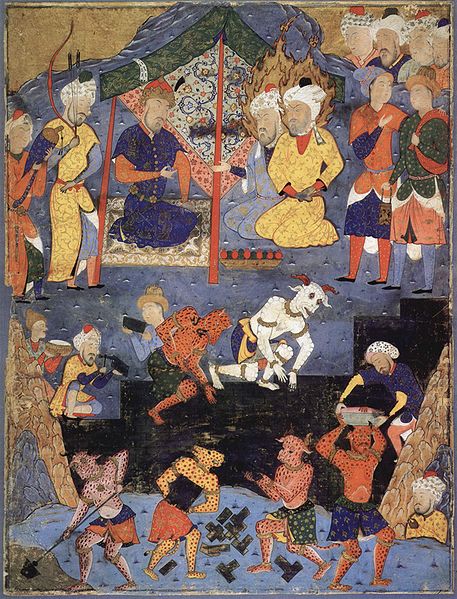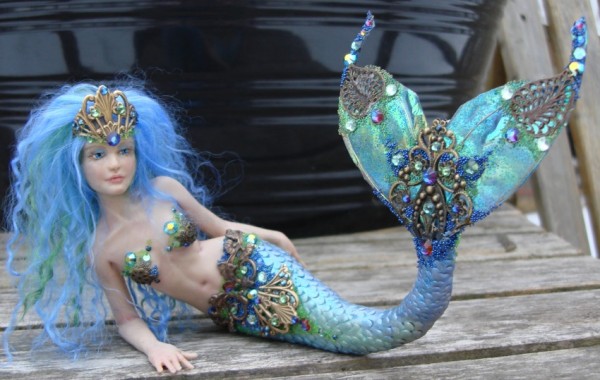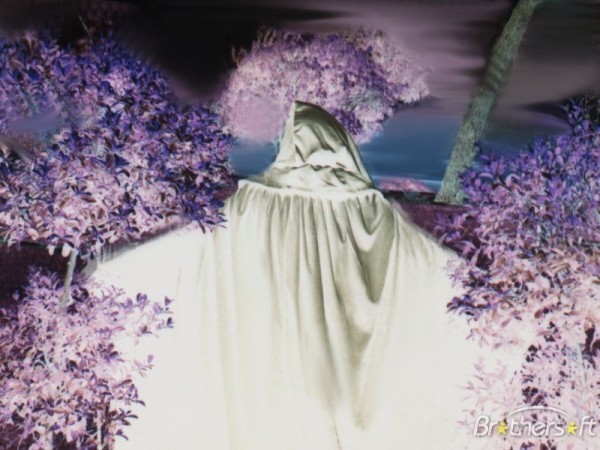1. Gog and Magog

Source
Gog Magog appear in the Qur’an, Book of Genesis, the Book of Ezekiel and the Book of Revelation. They are variously presented as supernatural beings, demons or national groups that lurked upon the land. Gog and Magog occur widely in mythology and folklore and their existence is accepted by many religions including Islam, Christianity and Judaism. The widely accepted belief both in Christianity and Islam holds that “He of the Two Horns” (a great and righteous ruler) or Two Ages (one who impacts on two ages) travelled the world in three directions, until he found a tribe threatened by Gog and Magog, who were of an “evil and destructive nature” and “caused great corruption on earth.” The people offered tribute in exchange for protection, he agreed to help them, but refused the tribute; he constructed a great wall that the hostile nations were unable to penetrate. They will be trapped there until doomsday, and their escape will be a sign of the end: “The War of Gog and Magog” would precede the return of Jesus.
2. Satyr
Source
Satyrs were originally seen as companions of the goat god Pan in ancient Greek civilisation . The first drawings of satyrs were of normal men, though often with an erect phallus. It was later merged with the Roman faun which is when they began to be depicted as half men half goats (the upper body being that of the man, and the lower half being that of a goat). Satyrs are described as roguish but faint-hearted folk — subversive and dangerous, yet shy and cowardly. Many early accounts which apparently refer to this animal describe the males as being sexually aggressive towards human women and towards females of its own species. In old age they are often seen with horns on their head, while young satyrs are seen with nubs instead.
3. Abarimon
Source
Abarimon is the name of a legendary race with backwards feet, but in spite of this handicap were able to run at great speed. They lived side by side with wild animals and attempts to capture them failed because they were so savage. They lived in a great valley of Mount Imaus (now called the Himalayan Mountains in Pakistan). There was a special quality of air which meant if it was breathed for a long period of time it would be impossible to breathe any other type of air and the inhabitants could never leave the valley alive.
4. Nephilim

Source
Nephilim are beings, who appear in the Hebrew Bible; specifically mentioned in the Book of Genesis and the Book of Numbers; they are also mentioned in other Biblical texts and in some non-canonical Jewish writings. They were called fallen ones because men’s hearts would fail at the sight of them. Some suggest that they were giants and when they fell, the ground shook, causing others to fall too. They might not be historical figures but ancient imagery with questionable meaning. Some view of them as the hybrid offspring of fallen angels and human women. In the Hebrew Bible there is also mention of Rephaites alongside Nephilims, who were an ancient race of giants.
5. Mermaid

Source
A mermaid is a mythological aquatic creature with a female human head and torso and the tail of a fish..The mermaids have been discussed since at least 5000 BC. Her origins are believed to be from the Great Queen Atargatis, who loved a mortal shepherd and unintentionally killed him. Ashamed, she jumped into a lake to take the form of a fish, but the waters would not conceal her divine beauty. Thereafter, she took the form of a mermaid—human above the waist, fish below. Mermaids were however noted in British folklore as unlucky omens – both foretelling disaster and provoking it. There is a high possibility that people had been confusing them with Sirenias (aquatic animals) or people suffering from a congenital disease Sirenomelia (aka mermaid syndrome in which a child is born with his or her legs fused together).
6. Banshee

Source
The Banshee is a female spirit in Irish mythology , usually seen as an omen of death and a messenger from the Otherworld. The story of the bean-sidhe began as a fairy woman keening at the death of important personages. In later stories, the appearance of the banshee could foretell the death. According to the legend, the banshee can appear in a variety of guises. Most often she appears as an ugly, frightening old lady, but can also appear as a stunningly beautiful woman of any age that suits her. Although not always seen, her mourning call is heard, usually at night when someone is about to die and usually around woods.
7. Abatwa

Source
In Zulu mythology , Abatwa are tiny humans said to be able to hide beneath a blade of grass and to be able to ride ants. They are said to live a nomadic lifestyle and are continually on the hunt for game. Legend states that if one happens to come across an Abatwa, one will typically be asked a question like, “From where did you first see me?” One must reply by saying one saw them from a mountain, or some far away area. They are said to be extremely sensitive about their size, and if one answers by saying that one only saw them right then for the first time, the Abatwa will try to kill them with poison arrows. Stepping on an Abatwa by accident is also said to be a death sentence. Due to their shy nature, they will only tolerate being seen by the very young (said to be anyone under the age of 4), by magicians, and by pregnant women. If a pregnant woman in her seventh month of pregnancy sees a male Abatwa, it is said that she will give birth to a boy.
8. Elf
Source
An elf is a being of Germanic mythology . The elves were originally thought of as a race of divine or semi-divine beings endowed with magical powers, which they use both for the benefit and the injury of mankind. In pre-Christian mythology, they appear to have been divided into light elves and dark elves. The earliest preserved description of elves comes from Norse mythology that holds that the men could be elevated to the rank of elves after death, Crossbreeding was possible between elves and humans in the Old Norse belief. Words for the nymphs of the Greek were translated to be same as “elves” or its variants by Anglo-Saxon scholars.
9. Cyclops
Source
In Greek and Roman mythology , a cyclops is a member of a primordial race of giants, each with a single eye in the middle of its forehead. It is a great possibility that people have been mistaken a congenital abnormality called Cyclopia in which the human baby is malformed having only one central eye.
10. Orc

Source
Orc is a word used to refer to various races of tough and warlike humanoid creatures in various fantasy settings. Orcs are often portrayed as misshapen humanoids who are brutal, warmongering, and sadistic. Orcs are described of varying size, ugly and filthy. They are fanged, bow-legged and long-armed, and some have dark skin as if burned. The author Tolkien describes them as “squat, broad, flat-nosed, sallow-skinned, with wide mouths and slant eyes … degraded and repulsive versions of the (to Europeans) least lovely Mongol-types”. They are portrayed as miserable, crafty and vicious beings.
11. Kapre
Source
Kapre is a Philippine mythical creature that could be characterized as a tree demon, but with more human characteristics. It is described as being a tall, brown, hairy male with a beard. Kapres are normally described as smoking a big tobacco pipe, whose strong smell would attract human attention. The term kapre comes from the Arabic “kaffir” meaning a non-believer in God. apres may make contact with people to offer friendship, or if it is attracted to a woman. If a Kapre befriends any human, especially because of love, the Kapre will consistently follow its “love interest” throughout life. Also, if one is a friend of the Kapre then that person has the ability to see it and if they were to sit on it then any other person could see it. Kapres are also said to play pranks on people, frequently making travelers become disoriented and lose their way in the mountains or in the woods.
12. Leperchaun

Source
Leprechauns have been linked to the Tuatha Dé Danann of Irish mythology who are thought to derive from the pre-Christian deities of Ireland. When the surviving stories were written, Ireland had been Christian for centuries, and the Tuatha Dé were represented as mortal kings, queens and heroes of the distant past; however there are many clues to their former divine status. Popular depiction shows leperchauns as being no taller than a small child. The leprechaun is said to be a solitary creature, whose principal occupation is making and mending shoes, and who enjoys practical jokes. According to William Butler Yeats, the great wealth of these fairies comes from the “treasure-crocks, buried of old in war-time”, which they have uncovered and appropriated.According to McAnally the leprechaun is the son of an “evil spirit” and a “degenerate fairy” and is “not wholly good nor wholly evil”.
13. Ogre

Source
Ogre possibly derived from Oegrus from Greek mythology who was the son of Greek blood shedder god. The word ogre is of French origin . Keeping the Greek myth, Oegrus might have cursed some people to ogres where an ogre is described large, cruel, monstrous and hideous humanoid monster. Also featured in mythology, folklore and fiction. Ogres have appeared in many classic works of literature. In art, ogres are often depicted with a large head, abundant hair and beard, a voracious appetite, and a strong body. The term is often applied in a metaphorical sense to disgusting persons. The French tale tells of them as inhabitants of kingdom of Logres [England].
14. Dziwożona

Source
Dziwozoana or Mamuna are female swamp demons in Slavic mythology known for being malicious and dangerous. Most at risk of becoming one of these demons after death were thought to be midwives, old maids, unmarried mothers, pregnant women who die before childbirth, as well as abandoned children. Sometimes they carry off young men to be their husbands.
15. Mono Grande
Source
They are described as ape-like hairy creatures with men-like torsos sighted in South America. They are reported as being aggressive to humans. However, they are unrecognized by a scientific consensus and myths that came to South America with European colonists.